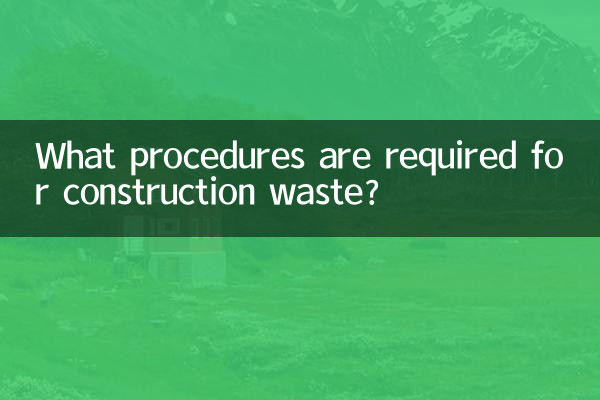What procedures are required for construction waste?
With the acceleration of urbanization, the problem of construction waste disposal has become increasingly prominent. Whether it is renovation, demolition or new construction, a large amount of construction waste will be generated. How to dispose of this waste legally and compliantly is a concern for many businesses and individuals. This article will introduce in detail the procedures and processes required for construction waste disposal and provide structured data for reference.
1. Definition and classification of construction waste

Construction waste refers to waste generated during project construction, demolition, decoration, etc., and mainly includes the following categories:
| Garbage type | Specific content |
|---|---|
| Engineering waste | Soil produced by excavation of foundations, foundation pits, etc. |
| Demolition trash | Bricks, concrete, etc. from building demolition |
| Decoration garbage | Wood, ceramic tiles, paint, etc. produced during the decoration process |
| Other garbage | Engineering waste, packaging materials, etc. |
2. Basic process of construction waste treatment
The following basic procedures need to be followed when disposing of construction waste:
| step | Specific content |
|---|---|
| 1. Declaration | Submit an application for construction waste disposal to the local urban management department or environmental protection department |
| 2. Approval | Relevant departments review application materials and issue construction waste disposal licenses |
| 3. Transportation | Entrust qualified transportation units to use special vehicles to transport construction waste |
| 4. Disposal | Transport construction waste to designated disposal sites or resource utilization centers |
| 5. Acceptance | After completing the disposal, submit an acceptance report to the relevant department |
3. Specific procedures required for construction waste disposal
Specific requirements may vary in different regions, but the following procedures are usually required:
| Procedure name | Handling department | Materials required |
|---|---|---|
| Construction waste disposal permit | Urban management department or environmental protection department | Application forms, engineering contracts, construction drawings, transportation contracts, etc. |
| Transport vehicle permit | traffic management department | Vehicle driving license, transportation unit qualification certificate, driver’s certificate, etc. |
| Acceptance certificate of the consumption site | Waste management department | Disposal contract, list of waste types and quantities, etc. |
4. Precautions
1.Legal compliance: Dumping construction waste without permission is illegal and may result in fines or other administrative penalties.
2.Classification processing: Construction waste should be classified and processed according to type, and recyclables should be utilized as resources as possible.
3.Choose a formal unit: When transporting and disposing of construction waste, be sure to choose a qualified unit to avoid environmental pollution or legal risks caused by irregular operations.
4.Report in time: Construction waste should be declared in advance before generation to avoid incomplete procedures affecting the progress of the project.
5. Hot Topics and Hot Content
Recently, the resource utilization of construction waste has become a hot topic. Here are some hot topics:
| topic | Main content |
|---|---|
| Construction waste recycling | Construction waste recycling technology has been promoted in many places, and waste concrete, bricks, etc. are processed into recycled building materials. |
| Intelligent supervision system | Some cities have launched smart supervision platforms for construction waste to enable full-process tracking of transportation and disposal. |
| Environmental protection policies are tightened | Many places have introduced new regulations to strengthen the crackdown on illegal dumping of construction waste |
The disposal of construction waste is not only related to environmental protection, but also an important part of urban sustainable development. Through legal and compliant procedures and scientific processing methods, we can reduce the negative impact of construction waste on the environment and promote the recycling of resources.

check the details

check the details